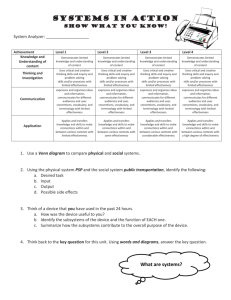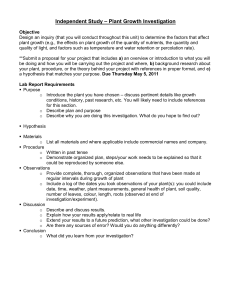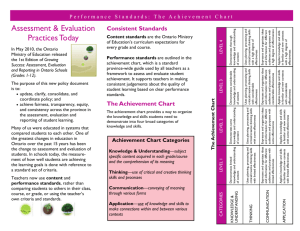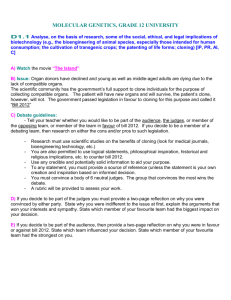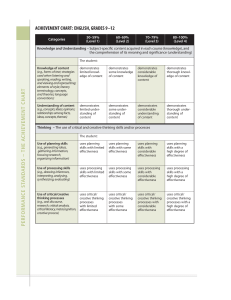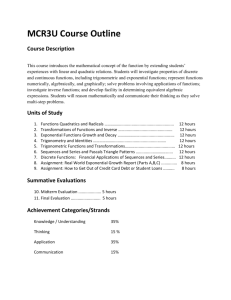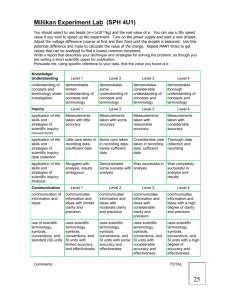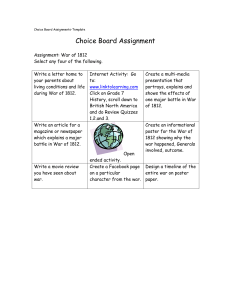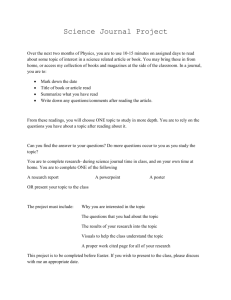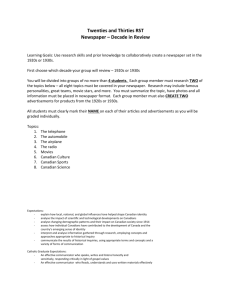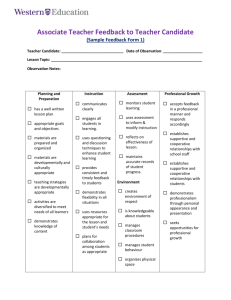SBI3U Debate Activity with RUBRIC
advertisement
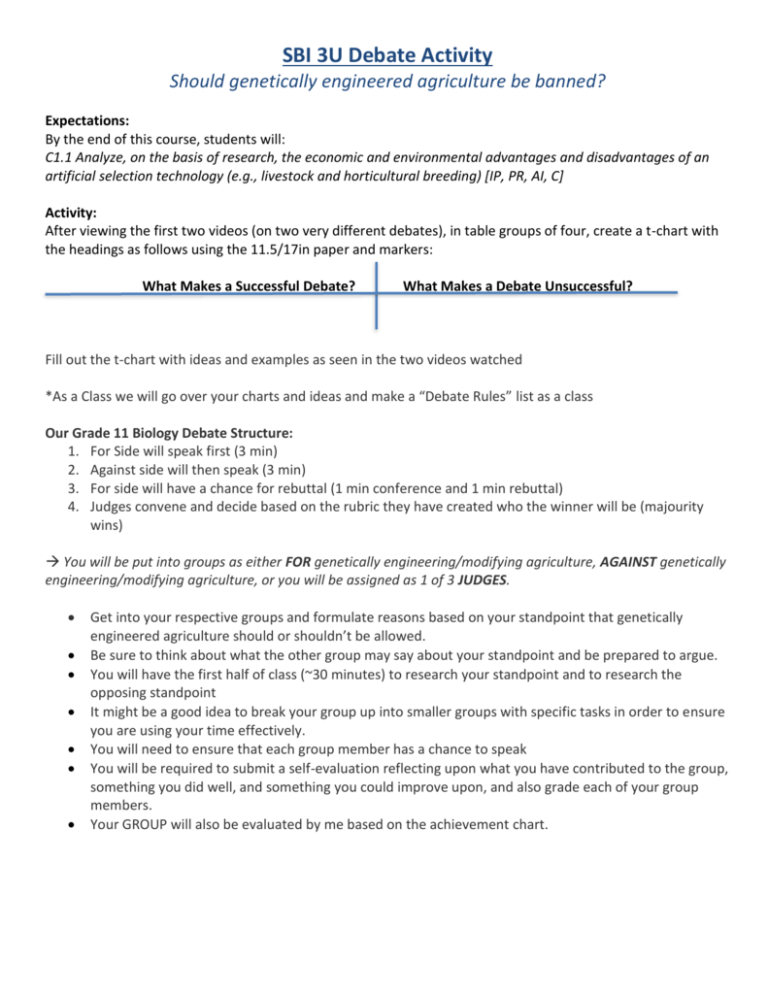
SBI 3U Debate Activity Should genetically engineered agriculture be banned? Expectations: By the end of this course, students will: C1.1 Analyze, on the basis of research, the economic and environmental advantages and disadvantages of an artificial selection technology (e.g., livestock and horticultural breeding) [IP, PR, AI, C] Activity: After viewing the first two videos (on two very different debates), in table groups of four, create a t-chart with the headings as follows using the 11.5/17in paper and markers: What Makes a Successful Debate? What Makes a Debate Unsuccessful? Fill out the t-chart with ideas and examples as seen in the two videos watched *As a Class we will go over your charts and ideas and make a “Debate Rules” list as a class Our Grade 11 Biology Debate Structure: 1. For Side will speak first (3 min) 2. Against side will then speak (3 min) 3. For side will have a chance for rebuttal (1 min conference and 1 min rebuttal) 4. Judges convene and decide based on the rubric they have created who the winner will be (majourity wins) You will be put into groups as either FOR genetically engineering/modifying agriculture, AGAINST genetically engineering/modifying agriculture, or you will be assigned as 1 of 3 JUDGES. Get into your respective groups and formulate reasons based on your standpoint that genetically engineered agriculture should or shouldn’t be allowed. Be sure to think about what the other group may say about your standpoint and be prepared to argue. You will have the first half of class (~30 minutes) to research your standpoint and to research the opposing standpoint It might be a good idea to break your group up into smaller groups with specific tasks in order to ensure you are using your time effectively. You will need to ensure that each group member has a chance to speak You will be required to submit a self-evaluation reflecting upon what you have contributed to the group, something you did well, and something you could improve upon, and also grade each of your group members. Your GROUP will also be evaluated by me based on the achievement chart. Achievement Chart – Science and Technology, Grades 1 -8 and Science, Grade 9 – 12 Categories 50-59% (Level 1) 60-69% (Level 2) 70-79% (Level 3) 80-100% (Level 4) Knowledge and Understanding Subject-specific content acquired in each grade (knowledge), and the comprehension of its meaning and significance (understanding) Knowledge of content (e.g., facts; terminology; definitions; safe use of tools, equipment, and materials) Understanding of content (e.g., concepts, ideas, theories, principles, procedures, processes) The student: - demonstrates limited knowledge of content - demonstrates limited understanding of content - demonstrates some knowledge of content - demonstrates considerable knowledge of content - demonstrates thorough knowledge of content - demonstrates some understanding of content - demonstrates considerable understanding of content - demonstrates thorough understanding of content Thinking and Inquiry -The use of critical and creative thinking skills, inquiry skills and/or processes The student: Use of initiating and planning skills and strategies - understanding the problem (e.g., formulating questions, identifying the problem, scheduling, selecting strategies and resources, developing preliminary ideas and plans) - making a plan for solving the problem Use of processing skills and strategies - carrying out a plan (e.g., performing and recording, gathering evidence, observing, manipulating materials and equipment) Use of critical/creative thinking processes, skills and strategies - looking back at the solution (e.g., analysing, interpreting, evaluating, forming conclusions, examining information and evidence ) - uses initiating and planning skills and strategies with limited effectiveness - uses initiating and planning skills and strategies with some effectiveness - uses initiating and planning skills and strategies with considerable effectiveness - uses initiating and planning skills and strategies with a high degree of effectiveness - uses processing skills and strategies with limited effectiveness - uses processing skills and strategies with some effectiveness - uses processing skills and strategies with considerable effectiveness - uses processing skills and strategies with a high degree of effectiveness - uses critical/creative thinking processes, skills and strategies with limited effectiveness - uses critical/creative thinking processes, skills and strategies with some effectiveness - uses critical/creative thinking processes, skills and strategies with considerable effectiveness - uses critical/creative thinking processes, skills and strategies with a high degree of effectiveness Categories 50-59% (Level 1) 60-69% (Level 2) 70-79% (Level 3) 80-100% (Level 4) Communication The conveying of meaning through various forms The student: Expression and organization of ideas and information (e.g., clear expression, logical organization) in oral, visual, and/or written forms Communication for different audiences (e.g., peers, adults) and purposes (e.g., to inform, to persuade) in oral, visual, and/or written forms - express and organizes ideas and information with limited effectiveness - express and organizes ideas and information with some effectiveness - express and organizes ideas and information with considerable effectiveness - express and organizes ideas and a high degree of effectiveness - communicates for different audiences and purposes with limited effectiveness - communicates for different audiences and purposes with some effectiveness - communicates for different audiences and purposes with considerable effectiveness - communicates for different audiences and purposes with a high degree of effectiveness Use of conventions, vocabulary, and terminology of the discipline in oral, visual, and/or written forms - uses conventions, vocabulary, and terminology of the discipline with limited effectiveness - uses conventions, vocabulary, and terminology of the discipline with some effectiveness - uses conventions, vocabulary, and terminology of the discipline with considerable effectiveness - uses conventions, vocabulary, and terminology of the discipline with a high degree of effectiveness Application The use of knowledge and skills to make connections within and between various contexts The student: Application of knowledge and skills (e.g., concepts, processes, use of equipment and technology, seeks answers to questions through inquiry, problem solving and decision making) in familiar contexts Making connections among science, technology, society, and the environment - - - applies knowledge and skills in familiar contexts with limited effectiveness - applies knowledge and skills in familiar contexts with some effectiveness - applies knowledge and skills in familiar contexts with considerable effectiveness - applies knowledge and skills in familiar contexts with a high degree of effectiveness - makes connections with limited effectiveness - makes connections with some effectiveness - makes connections with considerable effectiveness - makes connections with a high degree of effectiveness - proposes courses of practical action of limited effectiveness - proposes courses of practical action of some effectiveness - proposes courses of practical action of considerable effectiveness - proposes highly effective courses of practical action description of how science and technology affect the lives of people and other living things in their community assessment of impacts of science and technology on society and the environment Proposal of courses of practical action to deal with problems involving science, technology, society, and the environment
